
The Loop, one of Chicago's 77 designated community areas, is the central business district of the city and is the main section of Downtown Chicago. Home to Chicago's commercial core, it is the second largest commercial business district in North America and the world and contains the headquarters and regional offices of several global and national businesses, retail establishments, restaurants, hotels, and theaters, as well as many of Chicago's most famous attractions. It is home to Chicago's City Hall, the seat of Cook County, and numerous offices of other levels of government and consulates of foreign nations. In it, at the intersection of State Street and Madison Street, is the origin of Chicago's street grid addresses, established in 1909. Most of Grant Park's 319 acres (1.29 km2) are in the eastern section of the community area. The Loop community area is bounded on the north and west by the Chicago River, on the east by Lake Michigan, and on the south by Roosevelt Road, although the commercial core has greatly expanded into adjacent community areas.

Dearborn Station was, beginning in the late 1800s one of six intercity train stations serving downtown Chicago, Illinois. It remained in operation through to 1971. Built in 1883, it is located at Dearborn and Polk Streets, adjacent to Printers Row. The station was owned by the Chicago & Western Indiana Railroad, which itself was owned by the companies operating over its line. The station is now a shopping mall housing office, retail, and entertainment spaces.

The Magnificent Mile, sometimes referred to as The Mag Mile, is an upscale section of Chicago's Michigan Avenue, running from the Chicago River to Oak Street in the Near North Side. The district is located adjacent to downtown, and one block east of Rush Street. The Magnificent Mile serves as the main thoroughfare between Chicago's Loop business district and its Gold Coast. It is generally the western boundary of the Streeterville neighborhood, to its east and River North to the west.

The Chicago Pedway is a network of tunnels, ground-level concourses and bridges connecting skyscrapers, retail stores, hotels, and train stations throughout the central business district of Chicago, Illinois.

The Reliance Building is a skyscraper located at 1 W. Washington Street in the Loop community area of Chicago, Illinois. The first floor and basement were designed by John Root of the Burnham and Root architectural firm in 1890, with the rest of the building completed by Charles B. Atwood in 1895. It is the first skyscraper to have large plate glass windows make up the majority of its surface area, foreshadowing a design feature that would become dominant in the 20th century.
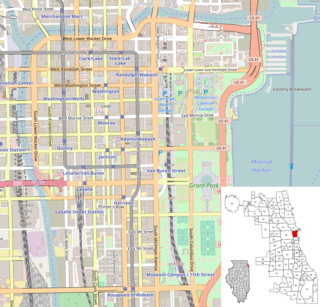
The Chicago Board of Trade Building is a 44-story, 604-foot (184 m) Art Deco skyscraper located in the Chicago Loop, standing at the foot of the LaSalle Street canyon. Built in 1930 for the Chicago Board of Trade (CBOT), it has served as the primary trading venue of the CBOT and later the CME Group, formed in 2007 by the merger of the CBOT and the Chicago Mercantile Exchange. In 2012, the CME Group sold the CBOT Building to a consortium of real estate investors, including GlenStar Properties LLC and USAA Real Estate Company.

The Printing House Row District is a National Historic Landmark District encompassing four architecturally important buildings on the 300 through 500 blocks of South Dearborn, South Federal and South Plymouth streets in the Loop community area of Chicago, Illinois. It was listed on the National Register of Historic Places as South Dearborn Street – Printing House Row Historic District and listed as a National Historic Landmark as South Dearborn Street – Printing House Row North Historic District on January 7, 1976. The district was designated a Chicago Landmark on May 9, 1996. The district includes the Monadnock Building, the Manhattan Building, the Fisher Building, and the Old Colony Building. The district overlaps significantly with the Printers Row neighborhood, and is not the same as South Loop Printing House District.

The Prairie Avenue District is a historic district in the Near South Side community area of Chicago, Illinois. It includes the 1800 and 1900 blocks of South Prairie Avenue and the 1800 block of South Indiana, and 211-217 East Cullerton. It was the site of the Battle of Fort Dearborn and became the city's most fashionable residential district after the Great Chicago Fire. It was designated a Chicago Landmark on December 27, 1979. The district was added to the National Register of Historic Places on November 15, 1972. The John J. Glessner House, designed and built by Henry Hobson Richardson in 1885–1886 at 1800 S. Prairie Avenue, has been restored as a historic house museum, and is open for public tours. In 2006, the Prairie District Neighborhood Alliance, a non-profit organization was formed to provide representation for thousands of South Loop residents, including the Prairie Avenue District, Central Station, Museum Park, Motor Row, and the South Michigan Avenue Corridor, as well as other areas of the Near South Side.

The One North LaSalle Building or One LaSalle Street Building is a building in the LaSalle Street corridor in the Loop community area of Chicago managed by MB Real Estate. It was for some time one of Chicago's tallest buildings. Built in 1930 by architects Vitzthum & Burns, it replaces the Tacoma Building by Holabird & Roche. The building is located across Madison Street from Roanoke Building. It was designated a Chicago Landmark on April 16, 1996, and added to the National Register of Historic Places on November 22, 1999. Its 5th floor relief panels depict the explorations of René-Robert Cavelier, Sieur de La Salle.

11 South LaSalle Street Building or Eleven South LaSalle Street Building is a Chicago Landmark building that is listed on the National Register of Historic Places and that is located at 11 South LaSalle Street in the Loop community area of Chicago, Illinois, United States. This address is located on the southeast corner of LaSalle and Madison Street in Cook County, Illinois across the Madison Street from the One North LaSalle Building. The building sits on a site of a former Roanoke building that once served as a National Weather Service Weather Forecast official climate site and replaced Major Block 1 after the Great Chicago Fire. The current building has incorporated the frontage of other buildings east of the original site of Major Block 1.
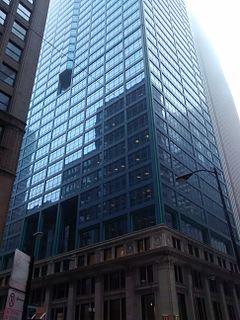
10 South LaSalle is a 502 ft tall skyscraper in the LaSalle Street financial district of Chicago, Illinois. It was completed in 1989 and has 37 floors, and is tied with One Superior Place for the 87th tallest building in the city.

The Mammoth Hot Springs Historic District in Yellowstone National Park comprises the administrative center for the park. It is composed of two major parts: Fort Yellowstone, the military administrative center between 1886–1918, and now a National Historic Landmark, and a concessions district which provides food, shopping, services, and lodging for park visitors and employees.

The Dearborn Inn, A Marriott Hotel, is a luxurious historic hotel, conceived by Henry Ford, who saw a need for food and accommodations for visitors flying into the nearby Ford Airport, making it one of the first airport hotels. It is located in Metro Detroit at 20301 Oakwood Boulevard in the suburban city of Dearborn, Michigan near The Henry Ford and the world headquarters building of Ford Motor Company. Albert Kahn designed the Dearborn Inn in the Georgian architectural style. The Dearborn Inn is owned by Ford Motor Land Development Corporation and managed by Marriott International.

The La Salle Hotel was a historic hotel that was located on the northwest corner of La Salle Street and Madison Street in the Chicago Loop community area of Chicago, Illinois, United States. It was situated to the southwest of Chicago City Hall and in very close proximity to St. Peter's Church. It was built between 1908 and 1909 by Holabird & Roche, contemporaneously with the Blackstone Hotel designed by Benjamin Marshall in a very similar style and at the time was Chicago's finest hotel.
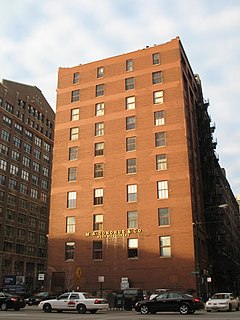
Printer's Row, also known as Printing House Row, is a neighborhood located south of the Chicago downtown area known as the Loop. The heart of Printer's Row is generally defined by Ida B. Wells Drive on the north, Polk Street on the south, Plymouth Court on the east, and the Chicago River on the west. This neighborhood overlaps significantly with the officially designated landmark Printing House Row District. The neighborhood includes Dearborn Station, which is also on the National Register of Historic Places.

The Guyon Hotel is a historic former hotel in Chicago, Illinois. The hotel was designed by Jensen J. Jensen - no relation to the famous landscape architect Jens Jensen - in 1927 and was built in red and cream brick with arched windows on two floors and exquisite, detailed terra cotta ornaments typical of Jensen's work. It was built at a cost of $1,650,000 by J. Louis Guyon, a French-Canadian nightclub owner and dance instructor.
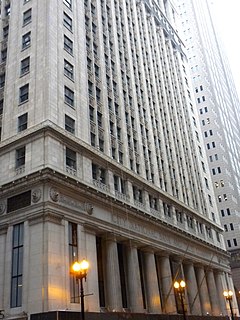
The Continental and Commercial National Bank is a historic office building located at 208 S. LaSalle Street in Chicago's Loop. The 21-story building was built in 1911-14 for the Continental and Commercial National Bank, at the time one of the largest banks in the nation. Architect Daniel Burnham designed the building in the Classical Revival style; Burnham, who was perhaps best known for his 1909 plan of Chicago, was a proponent of the style and used it in office buildings in multiple cities. The building's main entrance features a three-story colonnade with eight Doric columns; the eighteenth through the twentieth floors feature a matching colonnade, which forms the building's capital. A frieze and belt course separate the fourth and seventeenth floors from the shaft of the building, giving the building a small amount of horizontal emphasis. An open court occupies the center of the building, allowing natural light to reach its interior offices.

The West Loop–LaSalle Street Historic District is a historic district centered on LaSalle Street in the western Chicago Loop. The district was added to the National Register of Historic Places on June 1, 2013. A boundary increase on July 24, 2017 added two buildings at 330 S. Wells Street and 212 W. Van Buren Street to the district.
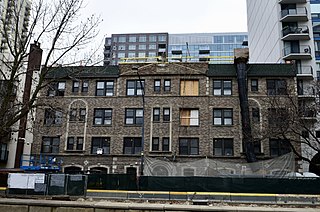
The Marshall Hotel is a historic residential hotel located at 1232 N. LaSalle Street in the Near North Side neighborhood of Chicago, Illinois. Built in 1927, the hotel was one of several residential hotels built to house an influx of workers to Chicago in the 1920s. While the hotel offered rooms to both temporary and permanent residents, census records indicate that most of its residents were permanent. Architect Edmund Meles, who designed several hotels and apartment buildings in Chicago in the 1920s, designed the building in a mix of the Classical Revival and Renaissance Revival styles. The building has a brick exterior and features a limestone arched entrance, arched lintels with keystones around the first-floor windows, limestone quoins, and a pediment with an urn.

222 North LaSalle, also known as the Builders Building, is a building located at 222 North LaSalle Street in the Chicago Loop. Built in 1927, it was significantly renovated between 1980 and 1986. It faces the south side of the Chicago River. A contributing property to the West Loop–LaSalle Street Historic District since 2013, it is currently owned by Tishman Speyer.























